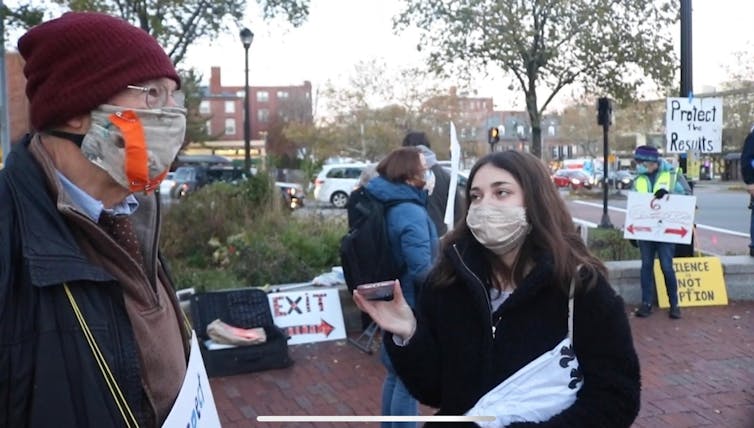 An Endicott College student covers Election Day in November 2020 in a Massachusetts community as part of the college’s news-academic partnership with Gannett Media.
An Endicott College student covers Election Day in November 2020 in a Massachusetts community as part of the college’s news-academic partnership with Gannett Media.
Sloan Friedhaber, CC BY-NC-ND
By Lara Salahi, Endicott College and Christina Smith, Georgia College and State University
Local news outlets across the U.S. are struggling to bring in advertising and subscription revenue, which pays for the reporting, editing and production of their articles. It’s not a new problem, but with fewer and fewer journalism jobs as a result, a growing number of local newsrooms have found a potential solution: college journalism students.
The pandemic, set on a backdrop of political and economic tumult, further injured a local news industry weakened by decades of revenue decline, ownership consolidation and cuts to production and delivery. In rural and urban communities across the country, residents have little or no access to credible or comprehensive local news and information – they live in what are called “news deserts.”
Studies show that people who live in news deserts or other locations with little local news are less likely to be actively involved in their community or participate in local elections. They are also more likely to believe false information spread online through social media and fake or fringe websites.
Through formal and informal collaborations, college journalists are helping to serve the communities where their universities are located by making sustained contributions to local media. Indeed, an estimated 10% of state capitol reporters across the nation are students. In some states, such as Missouri, students make up a little more than half of their statehouse press corps, according to a 2022 report published by the Pew Research Center.
As a researcher who studies trends in rural community journalism and a journalism professor who teaches in a region with significant elimination of local news reporters and news coverage, we decided to study these collaborations – what we call “news-academic partnerships” – often in areas that have seen local newsrooms suffer the hardest hits, as identified in the University of North Carolina’s news desert report.
For our initial research, we sent surveys to 50 people who are involved in these collaborations, either as faculty members who manage the partnership at a college and university or as journalists at a local news outlet who oversee the partnership. We got responses from more than two dozen of them and learned these partnerships are key ways to sustain local news in places where news coverage is diminishing or critical issues are going underreported.
Local connections
There is not a formal comprehensive list of collaborations between local newsrooms and college journalism programs, and there are many.
For instance, the University of Maryland’s Philip Merrill College of Journalism operates Capital News Service, which provides daily breaking and in-depth news stories by students on news stories in Maryland to partner news organizations, including television stations.
Some of these collaborations – such as ones between Franklin Pierce University and the Keene, New Hampshire, Sentinel newspaper – have existed for more than a decade. But our survey found that they have become more common over the past five years with further media consolidation and layoffs. Newer examples include the collaboration between Connecticut College and the local news site The Day.
Student opportunities
In 2019, one of us created a partnership between her beat reporting class at Endicott College in Massachusetts and Gannett, the largest newspaper chain serving communities north of Boston. That year, Gannett bought 21 publications in the North Shore region of Massachusetts with 32 editorial employees serving 22 communities – and downsized them to just 10 publications with 12 editorial personnel, Gannett staff told us.
In a class called Beat Reporting, Endicott students receive classroom instruction on finding and pitching story ideas, conducting interviews, simplifying complex information and structuring various types of stories. Each week the students are assigned to report on stories in cities and towns surrounding the college, to be published in Gannett’s local outlets. In many ways, the class runs like a newsroom, with students involved in every stage of news reporting. In addition to the professor, a Gannett editor works with students on each story, so students get the experience of receiving professional feedback as they see their story through to publication.
In early 2022, there are just nine Gannett publications employing seven full-time journalists serving that same territory. During the spring 2022 semester – the partnership’s fourth year running – 10 students enrolled in the course published over 65 news stories for those publications over the course of the spring 2022 semester. They have worked on stories ranging from environmental issues to health stories to local sports and to profiling community members with interesting stories to tell.
While the benefit to Gannett is clear here – an increase in its capabilities for a few months – students have also benefited from the partnership. Some are publishing their stories in news sites beyond a high school or college publication for the first time. In past semesters, a few students have stayed on with Gannett beyond the course to either intern or freelance for these local publications.
We hypothesize some partnerships, like this one, also benefit the communities that are served by these newspapers and websites, though that has yet to be studied. In some cases, the stories written by the student journalists would likely not have been covered because of limited capacity in the newsroom. Some community members whom students have reached out to for interviews told the students they were speaking to a journalist for the first time.
A 2019 survey conducted by the Pew Research Center found that only 21% of Americans say they’ve either spoken to or been interviewed by a local journalist, which has declined from 26% in 2016. Speaking with journalists can help build an understanding of how journalism works and increase trust in news.
Universities as partners
News-academic partnerships allow students to put the principles and techniques taught within classrooms into practice. We hypothesize that well-executed collaborations could arguably be seen as competitors to time- and resource-strapped newsrooms in the same coverage area. For now, though, it seems news-academic partnerships are just that: partnerships, and more collaborative than competitive.
We hope they might also lead to new journalistic endeavors, like the start of a new news outlet, or revival of an dying one. For example, in October 2021, the University of Georgia’s Grady College announced it would revive a nearby community newspaper that was slated to close.
However, it’s not an easy task. We have found that faculty members who seek to create or manage sustainable news-academic partnerships often find they face some of the same problems that editors at local news outlets report, such as burnout, high workloads and low pay. For instance, in a follow-up to our initial study, faculty members who oversaw a variety of news-academic partnerships reported receiving little or no additional compensation, nor a decrease in other responsibilities, such as teaching, to balance the workload.
The faculty members we spoke with also felt pressure to deliver professional-level multimedia journalism out of classrooms where students are still learning the craft, as well as the required technologies.
However, academic institutions are theoretically well positioned to sustain meaningful journalism that serves their communities, which are often outside of elite news coverage areas. Many are well funded and provide the physical and mental space for minds to build healthy skepticism and investigate complex issues in society. And many have housed public radio stations for decades, without imposing limits on editorial or financial independence. Even today, recognizing the possibility of political interference from university administrators, some stations have deliberately created policies to maintain their independence.
We think even more universities could be a source for reducing the number and size of news deserts in the U.S., and ensuring communities across the country retain a reliable source of news and information.![]()
Lara Salahi, Assistant Professor of Broadcast and Digital Journalism, Endicott College and Christina Smith, Associate Professor of Mass Communication, Georgia College and State University
This article is republished from The Conversation under a Creative Commons license. Read the original article.
Opinions expressed on this website are those of the authors alone and do not necessarily reflect or represent the views, policies or positions of the EJO or the organisations with which they are affiliated.
If you liked this story, you may also be interested in: Using digital solutions to protect the practice of investigative journalism
Tags: journalism students, local journalism, Newsroom Cutbacks














































